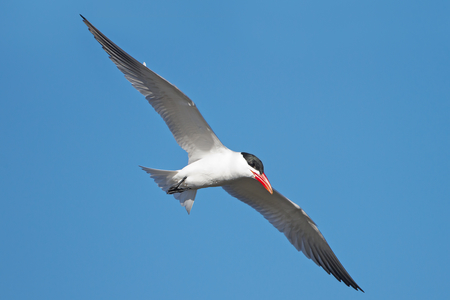Hydroprogne caspia
Family: Laridae
Length: 47 – 56 cm
Wingspan: 127 – 145 cm
Weight: 550 – 750 g

Identification
Appearance: medium-sized seabird with a large red-orange bill, a light grey mantle and white breast, face and undersides. Black legs and eyes. Solid black cap in breeding plumage.
Distinguishing characteristics: the largest of all terns.
Flight: more like a gull.
Sound: two types of call: low and hoarse.
Ecology and habitat
Nest: breeds on the sand or rocky beach; the nest is a shallow cavity in the ground, lined with algae, moss or marine vegetation, and blades of grass.
Diet: feeds on fish, aquatic invertebrates and crustaceans.
Behaviour at sea: rarely seen in the open ocean, prefers protected waters.
* This map indicates coastal nesting sites in the Mediterranean and adjacent Seas.
Distribution and movement
Breeding: almost worldwide in geographically isolated populations; including north Caspian (Volga Delta), and northern coast of the Black Sea. Small colonies in Turkey, Tunisia and Egypt (Gulf of Suez/Red Sea).
Wintering: in the eastern and central Mediterranean along the Guinean Gulf and in the Inner Niger Delta.
Phenology: Incubation: 20 – 22 days; two or three eggs. Chick-rearing: more than seven months after hatching (longest parental care observed in terns).
Conservation
Global population estimate: 250,000-470,000 individuals; European population: 11,800-14,800 pairs.
Threats: human disturbance, predation (crows, seagulls) and flooding.
Protection level: Barcelona Convention : Annex II; Bern Convention : Annex II; Birds Directive : Annex I; IUCN Red List: Least Concern.
Some key references
BirdLife International (2021) Species factsheet: Hydroprogne caspia.
Zwarts L., Bijlsma R. G., van der Kamp J., Wymenga E. (2009). Caspian Tern Sterna caspia. In Living on the Edge (pp. 370-377). KNNV Publishing.
